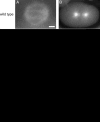Mutations of a redundant alpha-tubulin gene affect Caenorhabditis elegans early embryonic cleavage via MEI-1/katanin-dependent and -independent pathways
- PMID: 15781712
- PMCID: PMC1449697
- DOI: 10.1534/genetics.104.030106
Mutations of a redundant alpha-tubulin gene affect Caenorhabditis elegans early embryonic cleavage via MEI-1/katanin-dependent and -independent pathways
Abstract
The C. elegans zygote supports both meiosis and mitosis within a common cytoplasm. The meiotic spindle is small and is located anteriorly, whereas the first mitotic spindle fills the zygote. The C. elegans microtubule-severing complex, katanin, is encoded by the mei-1 and mei-2 genes and is solely required for oocyte meiotic spindle formation; ectopic mitotic katanin activity disrupts mitotic spindles. Here we characterize two mutations that rescue the lethality caused by ectopic MEI-1/MEI-2. Both mutations are gain-of-function alleles of tba-2 alpha-tubulin. These tba-2 alleles do not prevent MEI-1/MEI-2 microtubule localization but do interfere with its activity. TBA-1 and TBA-2 are redundant for viability, but when katanin activity is limiting, TBA-2 is preferred over TBA-1 by katanin. This is similar to what we previously reported for the beta-tubulins. Removing both preferred alpha- and beta-isoforms results in normal development, suggesting that the katanin isoform preferences are not absolute. We conclude that while the C. elegans embryo expresses redundant alpha- and beta-tubulin isoforms, they nevertheless have subtle functional specializations. Finally, we identified a dominant tba-2 allele that disrupts both meiotic and mitotic spindle formation independently of MEI-1/MEI-2 activity. Genetic studies suggest that this tba-2 mutation has a "poisonous" effect on microtubule function.
Figures






Similar articles
-
Roles for two partially redundant alpha-tubulins during mitosis in early Caenorhabditis elegans embryos.Cell Motil Cytoskeleton. 2004 Jun;58(2):112-26. doi: 10.1002/cm.20003. Cell Motil Cytoskeleton. 2004. PMID: 15083533
-
The Caenorhabditis elegans microtubule-severing complex MEI-1/MEI-2 katanin interacts differently with two superficially redundant beta-tubulin isotypes.Mol Biol Cell. 2004 Jan;15(1):142-50. doi: 10.1091/mbc.e03-06-0418. Epub 2003 Oct 17. Mol Biol Cell. 2004. PMID: 14565976 Free PMC article.
-
Katanin disrupts the microtubule lattice and increases polymer number in C. elegans meiosis.Curr Biol. 2006 Oct 10;16(19):1944-9. doi: 10.1016/j.cub.2006.08.029. Curr Biol. 2006. PMID: 17027492
-
The elegans of spindle assembly.Cell Mol Life Sci. 2010 Jul;67(13):2195-213. doi: 10.1007/s00018-010-0324-8. Epub 2010 Mar 26. Cell Mol Life Sci. 2010. PMID: 20339898 Free PMC article. Review.
-
Evidence mounts for receptor-independent activation of heterotrimeric G proteins normally in vivo: positioning of the mitotic spindle in C. elegans.Sci STKE. 2003 Aug 19;2003(196):pe35. doi: 10.1126/stke.2003.196.pe35. Sci STKE. 2003. PMID: 12928525 Review.
Cited by
-
Combinatorial Contact Cues Specify Cell Division Orientation by Directing Cortical Myosin Flows.Dev Cell. 2018 Aug 6;46(3):257-270.e5. doi: 10.1016/j.devcel.2018.06.020. Epub 2018 Jul 19. Dev Cell. 2018. PMID: 30032990 Free PMC article.
-
A tubulin-MAPKKK pathway engages tubulin isotype interaction for neuroprotection.Proc Natl Acad Sci U S A. 2025 Aug 26;122(34):e2507208122. doi: 10.1073/pnas.2507208122. Epub 2025 Aug 14. Proc Natl Acad Sci U S A. 2025. PMID: 40811477 Free PMC article.
-
Levels of the ubiquitin ligase substrate adaptor MEL-26 are inversely correlated with MEI-1/katanin microtubule-severing activity during both meiosis and mitosis.Dev Biol. 2009 Jun 15;330(2):349-57. doi: 10.1016/j.ydbio.2009.04.004. Epub 2009 Apr 8. Dev Biol. 2009. PMID: 19361490 Free PMC article.
-
Dendrimer-coated carbon nanotubes deliver dsRNA and increase the efficacy of gene knockdown in the red flour beetle Tribolium castaneum.Sci Rep. 2020 Jul 24;10(1):12422. doi: 10.1038/s41598-020-69068-x. Sci Rep. 2020. PMID: 32709999 Free PMC article.
-
Motor neuron synapse and axon defects in a C. elegans alpha-tubulin mutant.PLoS One. 2010 Mar 11;5(3):e9655. doi: 10.1371/journal.pone.0009655. PLoS One. 2010. PMID: 20300184 Free PMC article.
References
-
- Albertson, D. G., 1984. Formation of the first cleavage spindle in nematode embryos. Dev. Biol. 101: 61–72. - PubMed
-
- Baugh, L. R., A. A. Hill, D. K. Slonim, E. L. Brown and C. P. Hunter, 2003. Composition and dynamics of the Caenorhabditis elegans early embryonic transcriptome. Development 130: 889–900. - PubMed
-
- Bellanger, J. M., and P. Gonczy, 2003. TAC-1 and ZYG-9 form a complex that promotes microtubule assembly in C. elegans embryos. Curr. Biol. 13: 1488–1498. - PubMed
Publication types
MeSH terms
Substances
LinkOut - more resources
Full Text Sources

